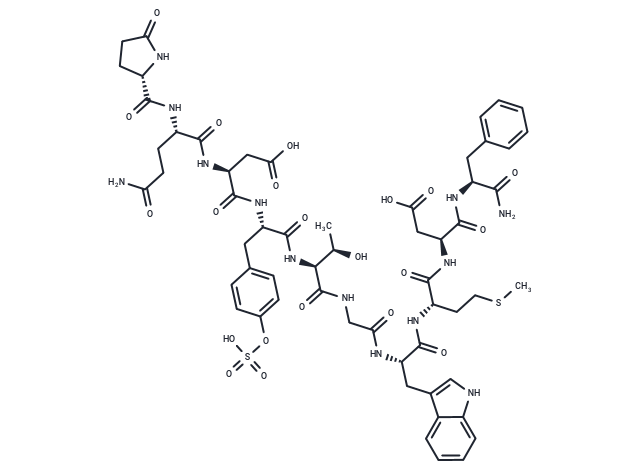 Your shopping cart is currently empty
Your shopping cart is currently empty

Ceruletide is a decapeptide that serves as a safe and effective cholecystokinin receptor agonist, exerting a direct spasmogenic effect on the gallbladder muscle and bile ducts, and is commonly used to establish pancreatitis models.

| Pack Size | Price | USA Warehouse | Global Warehouse | Quantity |
|---|---|---|---|---|
| 100 μg | $31 | In Stock | In Stock | |
| 500 μg | $56 | In Stock | In Stock | |
| 1 mg | $89 | In Stock | In Stock | |
| 5 mg | $347 | In Stock | - | |
| 10 mg | $538 | In Stock | - | |
| 25 mg | $856 | In Stock | - | |
| 50 mg | $1,150 | Inquiry | Inquiry |
| Description | Ceruletide is a decapeptide that serves as a safe and effective cholecystokinin receptor agonist, exerting a direct spasmogenic effect on the gallbladder muscle and bile ducts, and is commonly used to establish pancreatitis models. |
| Targets&IC50 | mice:1012 mg/kg (LD50) |
| In vitro | Ceruletide is biologically and chemically identical to the human gastrointestinal hormones cholecystokinin-pancreatin (CCK) and gastrin II;Ceruletide stimulates gallbladder contraction while delaying gastric emptying and inhibiting motility of the proximal duodenum [1]. Ceruletide activates NF-κB/Rel in vitro at high doses (but not physiological doses), which may induce a self-defense gene program before cell damage occurs and may protect pancreatic acinar cells from further damage after secretagogue overstimulation [2]. |
| In vivo | Ceruletide (5-15 ng/kg intravenously) has a significant spasmodic effect on the pylorus in rats[1]; Ceruletide (0.4-0.5 mcg/kg intravenously; 3-4 mcg/kg subcutaneously) causes vomiting and defecation in conscious dogs [3]. |
| Disease Modeling Protocol | Establishment of chronic pancreatitis model
*Precautions: Three days after the last cerulein injection, mice were sacrificed and pancreatic tissue samples were collected for observation. |
| Synonyms | FI-6934, Cerulein, Caerulein |
| Molecular Weight | 1352.4 |
| Formula | C58H73N13O21S2 |
| Cas No. | 17650-98-5 |
| Smiles | CSCC[C@H](NC(=O)[C@H](Cc1c[nH]c2ccccc12)NC(=O)CNC(=O)[C@@H](NC(=O)[C@H](Cc1ccc(OS(O)(=O)=O)cc1)NC(=O)[C@H](CC(O)=O)NC(=O)[C@H](CCC(N)=O)NC(=O)[C@@H]1CCC(=O)N1)[C@@H](C)O)C(=O)N[C@@H](CC(O)=O)C(=O)N[C@@H](Cc1ccccc1)C(N)=O |
| Relative Density. | 1.406g/cm3 |
| Color | White |
| Appearance | Solid |
| Sequence | {pGlu}-Gln-Asp-Tyr(SO3H)-Thr-Gly-Trp-Met-Asp-Phe-NH2 |
| Sequence Short | {pGlu}-QD-Y(SO3H)-TGWMDF-NH2 |
| Storage | keep away from moisture,store at low temperature | Powder: -20°C for 3 years | In solvent: -80°C for 1 year | Shipping with blue ice/Shipping at ambient temperature. | ||||||||||||||||||||||||||||||||||||||||
| Solubility Information | DMSO: 255 mg/mL (188.55 mM), Sonication is recommended. H2O: 5 mg/mL (3.7 mM), Sonication is recommended. | ||||||||||||||||||||||||||||||||||||||||
| In Vivo Formulation | 10% DMSO+40% PEG300+5% Tween 80+45% Saline: 5 mg/mL (3.7 mM), Sonication is recommended. Please add the solvents sequentially, clarifying the solution as much as possible before adding the next one. Dissolve by heating and/or sonication if necessary. Working solution is recommended to be prepared and used immediately. The formulation provided above is for reference purposes only. In vivo formulations may vary and should be modified based on specific experimental conditions. | ||||||||||||||||||||||||||||||||||||||||
Solution Preparation Table | |||||||||||||||||||||||||||||||||||||||||
H2O/DMSO
DMSO
| |||||||||||||||||||||||||||||||||||||||||
| Size | Quantity | Unit Price | Amount | Operation |
|---|

Copyright © 2015-2026 TargetMol Chemicals Inc. All Rights Reserved.